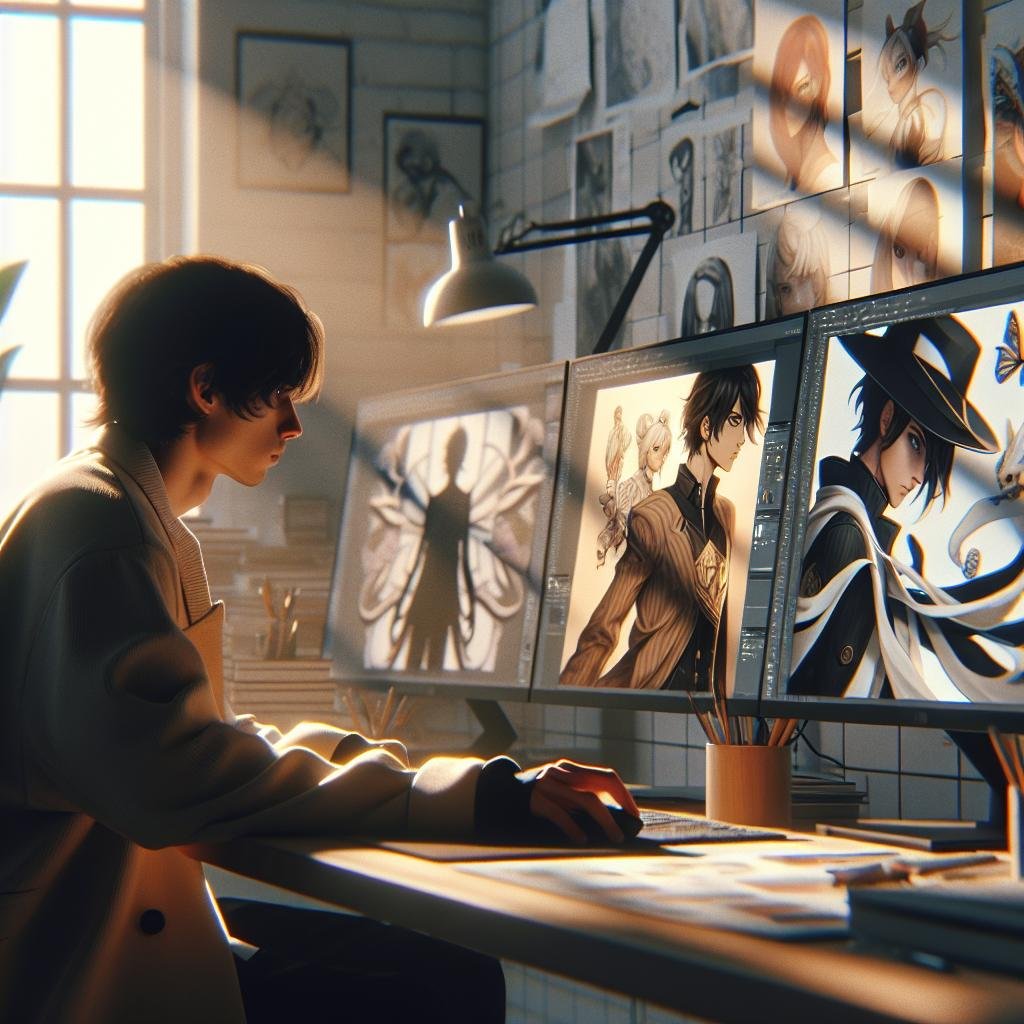
AI Image Controversy in Gaming | Essential Copyright Concerns
A significant controversy has erupted around legendary Shin Megami Tensei artist Kazuma Kaneko’s upcoming game “Nocturne of Soul.” The game features an AI image generation system that appears to produce images resembling Disney characters and other copyrighted content. This situation highlights the growing challenges at the intersection of artificial intelligence, gaming, and intellectual property rights as developers integrate AI tools into creative works.
The “Nocturne of Soul” AI Controversy Explained
Kazuma Kaneko, the artistic mind behind the iconic Shin Megami Tensei series, recently unveiled his independent project “Nocturne of Soul” at Tokyo Game Show 2023. The game features a unique mechanic called “Soul Snap” that allows players to generate character images using AI technology. However, players quickly discovered that this system could produce images strikingly similar to well-known intellectual properties, including Disney characters like Mickey Mouse.
The controversy began when promotional videos and demonstrations showed the AI generating images that closely resembled copyrighted characters. Japanese players testing the system reported successfully creating images reminiscent of Mickey Mouse, anime characters, and other recognizable figures by using specific text prompts like “a mouse with round ears” or character names from popular franchises.
What makes this particularly concerning is that these images appear within a commercial product that will be sold to consumers. This differs significantly from private AI experimentation and raises serious legal questions about copyright infringement and the responsibilities of game developers when implementing AI systems.
Understanding AI Image Generation in Gaming
The “Soul Snap” feature in Nocturne of Soul uses text-to-image AI technology, similar to systems like DALL-E or Midjourney. Players input descriptive text prompts, and the AI generates corresponding images. These generated characters then become companions within the game world.
AI image generators learn from massive datasets of images found across the internet. This learning process often includes copyrighted materials, which creates the potential for AI to reproduce elements of those works when given related prompts. While the technology doesn’t directly copy images, it creates new content based on patterns learned from existing works.
This technology represents an emerging frontier in gaming, offering players unprecedented creative freedom. However, it also introduces complex legal and ethical questions that the industry has yet to fully address.
Copyright Concerns with AI-Generated Content
The core issue with Nocturne of Soul’s AI system revolves around copyright law and fair use. When an AI system within a commercial product can generate images resembling protected intellectual property, several legal concerns arise:
- Direct copyright infringement if the AI produces images too similar to copyrighted characters
- Secondary liability for the game developer by providing tools that enable copyright infringement
- Trademark violations when recognized commercial characters appear in unrelated products
- Potential damage to brand reputation when characters appear in unauthorized contexts
Copyright law varies by country, but most jurisdictions protect creative works from unauthorized reproduction or derivative works. While fair use exceptions exist in the United States, determining whether AI-generated images qualify as fair use remains legally uncertain.
The situation becomes even more complex when considering that the game will be sold internationally, potentially subjecting it to different copyright laws across various regions.
Developer Responsibilities and Safeguards
As AI tools become more integrated into gaming, developers face increasing responsibility to implement safeguards against copyright infringement. Many AI companies have already incorporated filters and restrictions to prevent their systems from generating content that too closely resembles known intellectual properties.
For Nocturne of Soul, questions arise about what measures Kaneko’s team has implemented to prevent copyright violations. Some possible approaches include:
- Content filters that block specific prompts related to copyrighted characters
- Technical limitations on the AI to prevent it from generating certain visual patterns
- Clear user guidelines and terms of service prohibiting attempts to create copyrighted content
- Review processes for AI-generated content before it becomes part of the gameplay
The development team has yet to address these concerns publicly, leaving questions about their risk management strategy unanswered. This situation highlights the need for clearer industry standards as AI becomes more prevalent in gaming.
Real-World Example
This isn’t the first time AI-generated content has created legal headaches. In 2023, a children’s book author used AI to create illustrations for a story, only to discover later that some images contained elements strikingly similar to copyrighted characters. After publishing the book, the author faced cease-and-desist letters and eventually had to recall and remake the entire product at significant cost. This cautionary tale demonstrates the real financial and legal risks that come with commercial use of AI-generated imagery without proper safeguards.
The Broader Impact on Gaming and Creative Industries
The Nocturne of Soul controversy represents just one example of the growing tensions between AI technology and creative industries. Game developers increasingly want to harness AI’s potential while navigating complex intellectual property landscapes.
Several important trends and implications are emerging:
Player-Generated Content Risks
Games that allow players to generate content using AI tools potentially transfer some legal risk to the player. However, courts might still hold developers responsible for providing tools that facilitate copyright infringement, especially if adequate safeguards aren’t in place.
Changing Game Design Approaches
Developers may need to rethink how they implement AI systems, focusing on controlled generation within specific stylistic boundaries rather than open-ended creation. This could mean training AI on proprietary art styles or implementing stronger filters.
Legal Framework Evolution
Current copyright laws weren’t written with AI in mind. The gaming industry may need to advocate for clearer legal frameworks that balance innovation with intellectual property protection. This might include new licensing models specifically for AI training and generation.
The outcome of controversies like Nocturne of Soul could establish important precedents for how games integrate AI technology in the future. It may also influence how courts and lawmakers approach AI-generated content more broadly.
Cultural and Artistic Considerations
Beyond legal concerns, the situation raises interesting questions about creativity and artistic intent. Kazuma Kaneko has built his reputation on distinctive, original character designs throughout his career. The choice to implement AI-generated characters represents a significant shift in creative approach.
Some critics worry that increasing reliance on AI generation might dilute the unique artistic vision that makes games special. Others see AI as simply another tool that artists can use to expand creative possibilities.
The controversy also highlights cultural differences in how AI and copyright are perceived. Japanese copyright law differs from American and European frameworks in several key aspects, potentially creating different expectations about acceptable AI use in creative works.
Potential Solutions and Best Practices
As the gaming industry continues to explore AI integration, several approaches could help prevent similar controversies:
- Training AI models exclusively on properly licensed or public domain artwork
- Implementing robust technical safeguards against generating copyrighted content
- Creating clear documentation of AI development processes for legal protection
- Establishing industry standards for responsible AI use in games
- Developing new licensing frameworks specifically for AI training and generation
Game developers might also consider more transparent approaches to AI implementation, clearly communicating to players and copyright holders how their systems work and what limitations are in place.
For players excited about Nocturne of Soul, the controversy raises questions about whether the final released version will maintain the same AI functionality or if changes will be implemented before launch.
What This Means for the Future of Gaming
The Nocturne of Soul situation serves as an important test case for how AI-generated content will function within commercial gaming products. The resolution of this controversy could influence development practices across the industry.
If the game launches with unrestricted AI generation capabilities that produce content resembling copyrighted materials, it may face legal challenges that establish new precedents. If the developers implement stronger safeguards before release, it could demonstrate a viable path forward for AI integration.
Either way, this controversy highlights that the gaming industry is entering uncharted territory with AI implementation. The balance between creative freedom, technological innovation, and copyright protection remains delicate, requiring thoughtful approaches from developers, publishers, and platform holders.
Conclusion
The controversy surrounding Nocturne of Soul’s AI image generation system highlights the complex challenges facing game developers as they incorporate artificial intelligence into their creative works. While AI offers exciting possibilities for player creativity and game design, it also creates significant legal and ethical considerations regarding copyright and intellectual property.
As the gaming industry continues to explore AI integration, clearer guidelines, technical safeguards, and potentially new legal frameworks will be necessary to balance innovation with respect for intellectual property rights. The resolution of this particular controversy may establish important precedents for how games implement AI features in the future.
For players and developers alike, this situation serves as a reminder that technology often advances faster than legal and ethical frameworks, creating periods of uncertainty during which careful consideration is essential.
Have thoughts on how game developers should approach AI integration? Share your perspective in the comments below.


